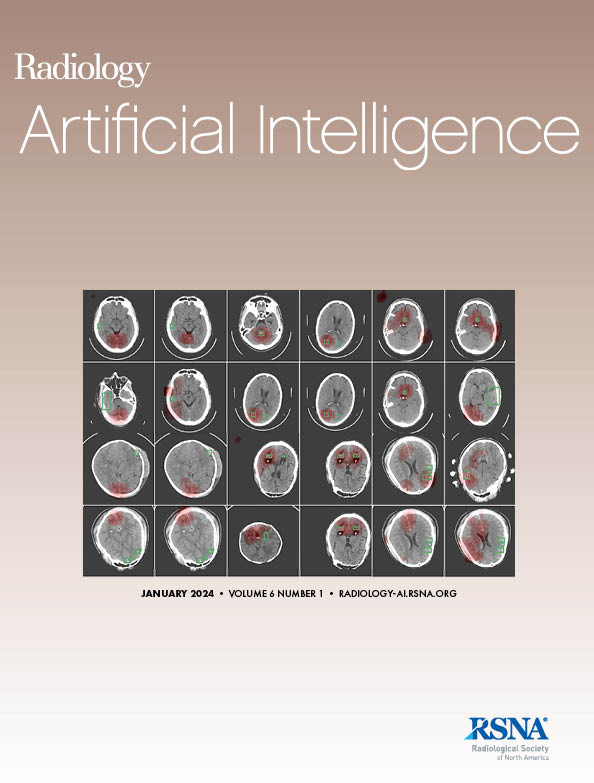Soroosh Tayebi Arasteh, Mahshad Lotfinia, Keno Bressem, Robert Siepmann, Lisa Adams, Dyke Ferber, Christiane Kuhl, Jakob Nikolas Kather, Sven Nebelung, Daniel Truhn
下载PDF
{"title":"RadioRAG:放射学问答的在线检索增强生成。","authors":"Soroosh Tayebi Arasteh, Mahshad Lotfinia, Keno Bressem, Robert Siepmann, Lisa Adams, Dyke Ferber, Christiane Kuhl, Jakob Nikolas Kather, Sven Nebelung, Daniel Truhn","doi":"10.1148/ryai.240476","DOIUrl":null,"url":null,"abstract":"<p><p>Purpose To evaluate diagnostic accuracy of various large language models (LLMs) when answering radiology-specific questions with and without access to additional online, up-to-date information via retrieval-augmented generation (RAG). Materials and Methods The authors developed radiology RAG (RadioRAG), an end-to-end framework that retrieves data from authoritative radiologic online sources in real-time. RAG incorporates information retrieval from external sources to supplement the initial prompt, grounding the model's response in relevant information. Using 80 questions from the RSNA Case Collection across radiologic subspecialties and 24 additional expert-curated questions with reference standard answers, LLMs (GPT-3.5-turbo [OpenAI], GPT-4, Mistral 7B, Mixtral 8×7B [Mistral], and Llama3-8B and -70B [Meta]) were prompted with and without RadioRAG in a zero-shot inference scenario (temperature ≤ 0.1, top-p = 1). RadioRAG retrieved context-specific information from <i>www.radiopaedia.org</i>. Accuracy of LLMs with and without RadioRAG in answering questions from each dataset was assessed. Statistical analyses were performed using bootstrapping while preserving pairing. Additional assessments included comparison of model with human performance and comparison of time required for conventional versus RadioRAG-powered question answering. Results RadioRAG improved accuracy for some LLMs, including GPT-3.5-turbo (74% [59 of 80] vs 66% [53 of 80], false discovery rate [FDR] = 0.03) and Mixtral 8×7B (76% [61 of 80] vs 65% [52 of 80], FDR = 0.02) on the RSNA radiology question answering (RSNA-RadioQA) dataset, with similar trends in the ExtendedQA dataset. Accuracy exceeded that of a human expert (63% [50 of 80], FDR ≤ 0.007) for these LLMs, although not for Mistral 7B-instruct-v0.2, Llama3-8B, and Llama3-70B (FDR ≥ 0.21). RadioRAG reduced hallucinations for all LLMs (rate, 6%-25%). RadioRAG increased estimated response time fourfold. Conclusion RadioRAG shows potential to improve LLM accuracy and factuality in radiology QA by integrating real-time, domain-specific data. <b>Keywords:</b> Retrieval-augmented Generation, Informatics, Computer-aided Diagnosis, Large Language Models <i>Supplemental material is available for this article.</i> © RSNA, 2025.</p>","PeriodicalId":29787,"journal":{"name":"Radiology-Artificial Intelligence","volume":" ","pages":"e240476"},"PeriodicalIF":13.2000,"publicationDate":"2025-07-01","publicationTypes":"Journal Article","fieldsOfStudy":null,"isOpenAccess":false,"openAccessPdf":"https://www.ncbi.nlm.nih.gov/pmc/articles/PMC12326075/pdf/","citationCount":"0","resultStr":"{\"title\":\"RadioRAG: Online Retrieval-Augmented Generation for Radiology Question Answering.\",\"authors\":\"Soroosh Tayebi Arasteh, Mahshad Lotfinia, Keno Bressem, Robert Siepmann, Lisa Adams, Dyke Ferber, Christiane Kuhl, Jakob Nikolas Kather, Sven Nebelung, Daniel Truhn\",\"doi\":\"10.1148/ryai.240476\",\"DOIUrl\":null,\"url\":null,\"abstract\":\"<p><p>Purpose To evaluate diagnostic accuracy of various large language models (LLMs) when answering radiology-specific questions with and without access to additional online, up-to-date information via retrieval-augmented generation (RAG). Materials and Methods The authors developed radiology RAG (RadioRAG), an end-to-end framework that retrieves data from authoritative radiologic online sources in real-time. RAG incorporates information retrieval from external sources to supplement the initial prompt, grounding the model's response in relevant information. Using 80 questions from the RSNA Case Collection across radiologic subspecialties and 24 additional expert-curated questions with reference standard answers, LLMs (GPT-3.5-turbo [OpenAI], GPT-4, Mistral 7B, Mixtral 8×7B [Mistral], and Llama3-8B and -70B [Meta]) were prompted with and without RadioRAG in a zero-shot inference scenario (temperature ≤ 0.1, top-p = 1). RadioRAG retrieved context-specific information from <i>www.radiopaedia.org</i>. Accuracy of LLMs with and without RadioRAG in answering questions from each dataset was assessed. Statistical analyses were performed using bootstrapping while preserving pairing. Additional assessments included comparison of model with human performance and comparison of time required for conventional versus RadioRAG-powered question answering. Results RadioRAG improved accuracy for some LLMs, including GPT-3.5-turbo (74% [59 of 80] vs 66% [53 of 80], false discovery rate [FDR] = 0.03) and Mixtral 8×7B (76% [61 of 80] vs 65% [52 of 80], FDR = 0.02) on the RSNA radiology question answering (RSNA-RadioQA) dataset, with similar trends in the ExtendedQA dataset. Accuracy exceeded that of a human expert (63% [50 of 80], FDR ≤ 0.007) for these LLMs, although not for Mistral 7B-instruct-v0.2, Llama3-8B, and Llama3-70B (FDR ≥ 0.21). RadioRAG reduced hallucinations for all LLMs (rate, 6%-25%). RadioRAG increased estimated response time fourfold. Conclusion RadioRAG shows potential to improve LLM accuracy and factuality in radiology QA by integrating real-time, domain-specific data. <b>Keywords:</b> Retrieval-augmented Generation, Informatics, Computer-aided Diagnosis, Large Language Models <i>Supplemental material is available for this article.</i> © RSNA, 2025.</p>\",\"PeriodicalId\":29787,\"journal\":{\"name\":\"Radiology-Artificial Intelligence\",\"volume\":\" \",\"pages\":\"e240476\"},\"PeriodicalIF\":13.2000,\"publicationDate\":\"2025-07-01\",\"publicationTypes\":\"Journal Article\",\"fieldsOfStudy\":null,\"isOpenAccess\":false,\"openAccessPdf\":\"https://www.ncbi.nlm.nih.gov/pmc/articles/PMC12326075/pdf/\",\"citationCount\":\"0\",\"resultStr\":null,\"platform\":\"Semanticscholar\",\"paperid\":null,\"PeriodicalName\":\"Radiology-Artificial Intelligence\",\"FirstCategoryId\":\"1085\",\"ListUrlMain\":\"https://doi.org/10.1148/ryai.240476\",\"RegionNum\":0,\"RegionCategory\":null,\"ArticlePicture\":[],\"TitleCN\":null,\"AbstractTextCN\":null,\"PMCID\":null,\"EPubDate\":\"\",\"PubModel\":\"\",\"JCR\":\"Q1\",\"JCRName\":\"COMPUTER SCIENCE, ARTIFICIAL INTELLIGENCE\",\"Score\":null,\"Total\":0}","platform":"Semanticscholar","paperid":null,"PeriodicalName":"Radiology-Artificial Intelligence","FirstCategoryId":"1085","ListUrlMain":"https://doi.org/10.1148/ryai.240476","RegionNum":0,"RegionCategory":null,"ArticlePicture":[],"TitleCN":null,"AbstractTextCN":null,"PMCID":null,"EPubDate":"","PubModel":"","JCR":"Q1","JCRName":"COMPUTER SCIENCE, ARTIFICIAL INTELLIGENCE","Score":null,"Total":0}
引用次数: 0
引用
批量引用

 求助内容:
求助内容: 应助结果提醒方式:
应助结果提醒方式:


